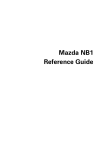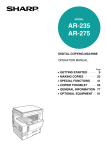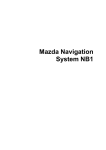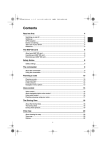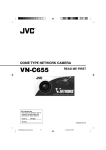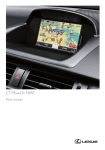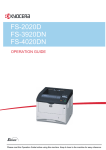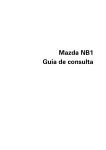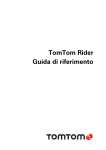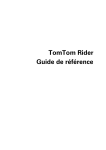Download Mazda Navigation system Specifications
Transcript
USA_NAVI_EN.book 1 ページ 2013年8月2日 金曜日 午後9時34分 Contents Read me first 4 Turning the system on and off ........................................................................................... 4 Setting up the system ........................................................................................................ 4 GPS reception ................................................................................................................... 4 System does not start........................................................................................................ 5 Taking care of the system.................................................................................................. 5 Reference .......................................................................................................................... 5 The MAP SD card 6 About the SD card ............................................................................................................. 6 Inserting the SD card......................................................................................................... 6 Removing the SD card ...................................................................................................... 7 Safety Notice 8 Safety settings ................................................................................................................... 8 The commander 9 About the commander ....................................................................................................... 9 Using the commander ....................................................................................................... 9 Planning a route 10 Planning a route .............................................................................................................. 10 Route summary ............................................................................................................... 12 Navigation menu options ................................................................................................. 12 Voice control 14 Voice control .................................................................................................................... 14 Using voice control .......................................................................................................... 15 Planning a journey using your voice ................................................................................ 16 The Driving View 17 About the Driving View .................................................................................................... 17 The Driving View ............................................................................................................. 17 Driving View Symbols...................................................................................................... 18 View map 19 About viewing the map .................................................................................................... 19 View map ......................................................................................................................... 19 Options ............................................................................................................................ 21 1 ©2013 Mazda Motor Corporation Printed in Japan Aug. 2013(Print2) USA_NAVI_EN.book 2 ページ 2013年8月2日 金曜日 午後9時34分 Map corrections 22 About Map Share............................................................................................................. 22 Sounds and voices 23 About sounds and voices ................................................................................................ 23 About computer voices .................................................................................................... 24 Selecting a voice ............................................................................................................. 24 Changing the volume level .............................................................................................. 24 Settings 25 About Settings ................................................................................................................. 25 Home location.................................................................................................................. 25 Favorites .......................................................................................................................... 25 Safety settings ................................................................................................................. 26 Show POI on map ........................................................................................................... 29 Switch map ...................................................................................................................... 29 Turn off voice guidance / Turn on voice guidance............................................................ 29 Reset factory settings ...................................................................................................... 30 Help 31 About getting help............................................................................................................ 31 Using Help to drive to a local service .............................................................................. 31 Help menu options........................................................................................................... 31 Traffic 33 About traffic information................................................................................................... 33 About TomTom HD Traffic ................................................................................................ 33 Using traffic information................................................................................................... 34 Checking traffic incidents in your area............................................................................. 35 Speed cameras 36 Important ......................................................................................................................... 36 Important ......................................................................................................................... 36 Speed Camera warnings ................................................................................................. 36 Report button................................................................................................................... 36 Reporting incorrect camera alerts ................................................................................... 37 Changing the way you are warned .................................................................................. 37 TomTom HOME 38 About TomTom HOME (the program) .............................................................................. 38 Installing TomTom HOME ................................................................................................ 38 MyTomTom account......................................................................................................... 39 Updating the Navigation system...................................................................................... 40 Updating the navigation system with the new application ............................................... 41 2 USA_NAVI_EN.book 3 ページ 2013年8月2日 金曜日 午後9時34分 Customer support 43 Getting help to the use navigation system....................................................................... 43 Status & information ........................................................................................................ 43 Addendum 44 Important Safety Notices and Warnings .......................................................................... 44 Copyright notices 48 3 USA_NAVI_EN.book 4 ページ 2013年8月2日 金曜日 午後9時34分 Read me first Turning the system on and off The Navigation system turns on when your vehicle starts and turns off automatically when you turn off your vehicle's engine. Until a connection has been established between the Audio control unit and the Navigation system, the screen shows audio-related information and the Nav button on the main display is inactive. If the Navigation system is restarted, press the Nav button. A Mazda/TomTom screen is shown at first, followed by the main screen (which may take up to 30 seconds to appear). Under extreme temperature conditions, the navigation system may not start. The system should start once the temperature in the vehicle reaches a normal range. If the system fails to start automatically in this situation, the vehicle's engine may need to be turned off and restarted. Note: In some situations, your navigation system may restart when turning the ignition from ACC-ON to the engine start position. If this happens, it may take up to 30 seconds for the main screen to appear on the navigation system. Setting up the system Important: Make sure to select the desired language. The language you choose will be used for all text on the screen. When the system is first started, you have to answer a few questions for set up. Answer the questions by tapping the screen. GPS reception When you first start the Navigation system, it may need a few minutes to determine your GPS position and show your current position on the map. After that, your position will be found much faster, usually within a few seconds. In areas where GPS reception is not possible, such as tunnels, your location may not be accurate. Important: The GPS antenna is located in the dashboard, so do not put objects on top of the dash. 4 USA_NAVI_EN.book 5 ページ 2013年8月2日 金曜日 午後9時34分 System does not start In rare cases, the TomTom navigation system may not start correctly or may stop responding to taps on the screen. This can happen if the device temperature is too high or too low, which causes the system to shut down. In rare circumstances, you may need to reset the navigation system. To reset the system, turn off the vehicle's engine and then remove the MAP SD card. Re-insert the MAP SD card and restart the engine. Taking care of the system It is important to take care of the system as follows: The system is not designed for use in extreme temperatures, and any such exposure may cause permanent damage. Do not open the casing of the system under any circumstances. Doing so may be dangerous and will void the warranty. Important: If you sell the vehicle, you should remove all personal information from the navigation system first. To remove your personal information, tap Settings and then tap Reset factory settings. Reference Refer to online manual for full operations. URL :www.mazdausa.com/navigation www.mazdanav.com Depending on the region in which the system is used, there may be differences in the functions/displayed specifications that can be used. 5 USA_NAVI_EN.book 6 ページ 2013年8月2日 金曜日 午後9時34分 The MAP SD card About the SD card A SD card is supplied with the navigation system. It includes a map of the country or group of countries. Updates are regularly produced by TomTom, particularly for maps and services like speed cameras. These updates are only available for download by inserting the navigation system's SD card into a computer that is connected to the internet. Once your new vehicle has been delivered, if a newer version of the map is available within 60 days, you can download this map for free. Important: In order to qualify for the latest map guarantee, you need to check if a new map is available within the 60 day period. You are only entitled to one free map download. Inserting the SD card To insert the SD card into the Navigation system in the vehicle do the following: 1. Switch off the ignition in the vehicle so that the navigation system turn off. 2. Open the sliding door and insert the SD card, taking care to handle it carefully and making sure it is right side up. Note: Only use the SD card for operating and updating the navigation system. Do not insert the SD card into another vehicle or into any other device such as a camera. 6 USA_NAVI_EN.book 7 ページ 2013年8月2日 金曜日 午後9時34分 Removing the SD card To remove the SD card from the Navigation system in the vehicle, do the following: 1. Switch off the ignition in the vehicle so that the navigation system turn off. 2. Slide the door open and push gently on the SD card. 3. Remove the SD card, handling it carefully. Important: Use the SD card only after the doors are securely closed. Switch the ignition off before inserting/removing the SD card. Data could be possibly written on the SD card directly after the sliding door is opened. DO NOT remove the SD card for about 3 seconds after turning the ignition off and opening the sliding door. When replacing the Navigation system due to damage, it is necessary to update the SD card from TomTom Home so that the SD card information can be re-read. Consult your dealer for details. Only use a genuine Mazda SD card. DO NOT use any other SD card In case the SD card is damaged, personal data on the SD card cannot be guaranteed. The user can backup and restore data using TomTom Home. Refer to www.mazdausa.com/navigation for details. 7 USA_NAVI_EN.book 8 ページ 2013年8月2日 金曜日 午後9時34分 Safety Notice Some TomTom navigation systems contain a GSM/GPRS module which can interfere with electrical devices such as cardiac pacemakers, and hearing aids. Interference with these devices may endanger your health or life, or that of others. The system is in the vehicle and cannot be operated in a hospital or airplane. Safety settings We recommend using the safety settings to make your driving as safe as possible. These are some of the options included in the safety settings: • Show safety reminders • Warn when driving faster than allowed Navigation operation - Avoid operating the system while driving. Operate the system only after stopping the vehicle. - Do not focus your attention on the display while driving, otherwise an accident could occur as a result of not paying attention to the road. - Always obey local traffic laws where the vehicle is being driven. 8 USA_NAVI_EN.book 9 ページ 2013年8月2日 金曜日 午後9時34分 The commander About the commander The commander is an input device located near the arm rest of your car in the central console. It has a central stick that you can move in the following ways: • Push in • Rotate left or right • Push the stick forwards or backwards • Push the stick left or right Using the commander 1. Push in - selects the item highlighted, For example, when the volume control is highlighted on the middle panel of the status bar in the Driving View, pushing in on the commander switches items on or off. 2. Rotate left or right - operates slider bars, such as the volume control, and zoom in/out in the Driving View. 3. Push forward or back - moves the focus around the different areas of the screen or around the map when browsing. 4. Push left or right - moves you between pages in a menu or between tabs on a screen. Examples of how to carry out common tasks using the commander • To access the Main menu from the Driving View, push the button in. • To zoom in or out in the Driving View, use rotate right and left. • When focused on the map in the Driving View, push right to access the traffic menu. • When focused on the map in the Driving View, push left to access the quick menu. • When focused on the map in the Driving View, push back towards you to access the volume control in the center panel of the status bar. • To access the Driving View from the Main menu, push the stick back towards you until you are focused on the Done button, then push the button in. • To move between letters on the keyboard screen, push left or right. Use push up or back to move to the letter above or below. You can also use rotate left or right to move between letters. 9 USA_NAVI_EN.book 10 ページ 2013年8月2日 金曜日 午後9時34分 Planning a route Planning a route Important: In the interest of safety and to reduce distractions while you are driving, you should always plan a route before you start driving. To plan a route on the Navigation system, do the following: 1. Tap the screen to open the Main menu. 2. Tap Navigate to. 3. Tap Address. You can change the country or state setting by tapping the flag before you select a city. 4. Enter the town or city name. Tip: Instead of typing the address, tap the microphone button to enter the address by speaking to the Navigation system using voice control. Towns with similar names are shown in the list while you type. When the correct city or town appears in the list, tap the name to select the destination. 5. Enter the streetname. Streets with similar names are shown in the list while you type. 10 USA_NAVI_EN.book 11 ページ 2013年8月2日 金曜日 午後9時34分 When the correct street name appears in the list, tap the name to select the destination. 6. Enter the house number, then tap Done. 7. The location is shown on the map. Tap Select to continue or tap Back to enter another address. Tip: If you want your final destination to be a parking lot or garage, tap Car park to select a location from the list of parking lots or garages close to your general destination. 8. When the new route is shown, tap Done. For more information about the route, tap Details. 11 USA_NAVI_EN.book 12 ページ 2013年8月2日 金曜日 午後9時34分 To change your route, to travel via a particular location, or to select a new destination, tap Change route. The Navigation system will start to guide you to your destination, using spoken instructions and on-screen directions. Route summary The route summary shows an overview of your route, the remaining distance to your destination and the remaining estimated journey time. To view the route summary, tap the right-hand panel on the status bar in the Driving view or tap View route in the Main menu and then tap Show route summary. If you have a TomTom HD Traffic service or an RDS-TMC receiver, the route summary also shows traffic information about delays on your route. Navigation menu options When you tap Navigate to, you can set your destination in many ways, not just by entering the address. The other options are listed below: Tap this button to navigate to your Home location. You will probably use this button more than any other. Home Tap this button to select a Favorite place as your destination. Favorite 12 USA_NAVI_EN.book 13 ページ 2013年8月2日 金曜日 午後9時34分 Tap this button to enter an address as your destination. Address Tap this button to select your destination from a list of places you have recently used as destinations. Recent destination Tap this button to navigate to a Point of Interest (POI). Point of Interest Tap this button to select a point on the map as your destination using the map browser. Point on map Tap this button to enter a destination using latitude and longitude values. Latitude Longitude Tap this button to enter a destination by voice. Spoken Address 13 USA_NAVI_EN.book 14 ページ 2013年8月2日 金曜日 午後9時34分 Voice control Voice control Instead of tapping the screen to control the Navigation system, you can use voice to control it. For example, to increase the volume on the Navigation system, say, "Increase volume" or "Volume 50%". To view the list of available commands, tap Help in the Main menu, then tap Product manuals and then tap What can I say. A User's Guide is also available from TomTom which can be downloaded online. Important: Voice control requires a computer voice. When there are no computer voices installed on the Navigation system, this feature is not available. To select a computer voice, tap Voices in the Settings menu, then tap Change voice and select a computer voice. 14 USA_NAVI_EN.book 15 ページ 2013年8月2日 金曜日 午後9時34分 Using voice control Voice control is turned on by default if it is supported by the chosen language. The following example shows how to use voice control to plan a journey to your Home address: 1. Tap the microphone button in the Driving view to turn on the microphone. A screen with examples of commands you can say appears. Tap Help in the Main menu, then tap Product manuals followed by What can I say to see a full list of commands you can say. When you hear "Say a command after the beep" followed by a tone, say a command. For example, you can say "Drive home". The Navigation system is only ready to listen after you hear the tone. After the beep. Important: You must wait for the beep which takes several seconds. While you are speaking the microphone monitor shows how well the system can hear your voice: A green bar means the system can hear your voice. A red bar means your voice is too loud for the system to recognize individual words. A gray bar means your voice is too quiet for the system to recognize individual words. For some phrases, the Navigation system repeats what you say and asks for confirmation. Tip: For the best recognition of what you say, speak normally without trying to articulate words in an unnatural way. If there is excessive road noise, for example, you may need to speak in the direction of the microphone. 2. If the command is correct, say "Yes." If the command is incorrect, say "No" and repeat the command after you hear the prompt and tone again. The Navigation system plans a route from your current location to your destination. Tip: To stop your Navigation system from listening for further commands, say "Cancel". To go back one step, say "Back". 15 USA_NAVI_EN.book 16 ページ 2013年8月2日 金曜日 午後9時34分 Planning a journey using your voice Note: It's not possible to plan a route using your voice for all maps in all countries, or in all languages. You can navigate to any of the following types of places using your voice: • An address, including home. • Cities and towns and their centers. • Favorites. • POI categories. • POIs for named brands. (for example, restaurants, gas stations, car rental and gyms.) • A recent destination. To plan a route to an address using speech, do the following: 1. Tap the voice control button in the Driving view. 2. When you hear the tone, you can say, for example "Drive to an address". Tip: The Navigation system has Navigate to on the button in the Main Menu. When planning a route to an address using speech, say "Navigate to address" if the button shows Navigate to. 3. Say the full address for your destination (for example, 112 James Street, Los Angeles, CA). Numbers can be pronounced naturally or one at a time. For example, 357 can be pronounced as "Three fifty seven" or "Three, five, seven". The Navigation system tells you what it heard. 4. Say "Yes" if the address is correct. If shown a list of addresses, say the list number for the correct address or say "none of these". If part of the address is incorrect, you can say something like "change the number", "change the street", "change the city" or "change the state" to correct the incorrect part. To begin again, say "start over". The Navigation system starts to guide you to your destination, using spoken instructions and onscreen directions. Tips: You can also use your voice to search for the nearest Point of interest (POI) category by saying something like "Drive to the nearest doctor". To select a Recent destination or a Favorite, say "Drive to a recent destination" or "Drive to a Favorite". 16 USA_NAVI_EN.book 17 ページ 2013年8月2日 金曜日 午後9時34分 The Driving View About the Driving View When the Navigation system starts for the first time, you are shown the Driving View along with detailed information about your current position. Tap the center of the screen at any time to open the Main Menu. The Driving View 1 2 5 6 7 3 4 8 1. Zoom button - tap the magnifying glass to show buttons for zooming in and out. 2. Your current position. 3. Road sign information or the next street name. 4. Traffic sidebar. Tap the sidebar to open the Traffic menu. The traffic sidebar is only shown if your device has either an HD Traffic subscription or an RDS-TMC Receiver connected. Traffic information is not available in all states, countries or regions. 5. Microphone button for voice command and control. 17 USA_NAVI_EN.book 18 ページ 2013年8月2日 金曜日 午後9時34分 6. The time, your current speed and the speed limit, if known. To see the difference between your preferred arrival time and your estimated arrival time, check the Leeway checkbox in the Status bar settings. Note: Not all options may be available. Tap this part of the status bar to switch between a 3D map and a 2D map. 7. The name of the street you are on. 8. Navigation instruction for the road ahead and the distance to next instruction. If the second instruction is less that 150m after the first instruction, you see it shown immediately instead of the distance. Tap this part of the status bar to repeat the last voice instruction and to change the volume. You can also tap here to mute the sound. 1. The remaining journey time, the remaining distance and your estimated arrival time. Tap this part of the status bar to open the Route Summary screen. To change the information shown in the status bar, tap Status bar in the Settings menu. Driving View Symbols Sound muted - this symbol is shown when the sound has been muted. To turn the sound back on, tap the middle panel in the status bar. 18 USA_NAVI_EN.book 19 ページ 2013年8月2日 金曜日 午後9時34分 View map About viewing the map You can view the map in the same way as you might look at a traditional paper map. The map shows your current location and many other locations such as Favorites and POIs. To view the map in this way, tap View map or View route in the Main menu. You view different locations on the map by moving the map across the screen. To move the map, touch the screen and drag your finger across the screen. To select a location on the map, tap the location on the map. The cursor highlights the location and displays useful information about the location in an information panel. Tap the information panel to create a Favorite or plan a route to that location. View map 1 4 2 5 3 6 7 Important: Not all features on this screen can be controlled using the commander. Use the touch screen instead. 1. The scale bar 2. Traffic - current traffic incidents. Use the Options button to select whether traffic information is shown on the map. When traffic information is shown on the map, POIs and Favorites are not shown. Note: To use a TomTom traffic information service, you may need a subscription. Traffic services are not supported in all states, countries or regions. For more information, visit www.mazdausa.com/navigation. 19 USA_NAVI_EN.book 20 ページ 2013年8月2日 金曜日 午後9時34分 3. Marker Markers point to your current location (blue), your home location (yellow) and your destination (red). The marker shows the distance to the location. Tap a marker to center the map on the location pointed to by the marker. You can also set your own marker. Tap the cursor button, then tap Set marker position to place a green marker at the cursor position. To turn markers off, tap Options, then Advanced and clear the Markers checkbox. 4. Options button 5. The cursor with street name balloon Tap the button in the street name balloon to open the cursor menu. You can navigate to the cursor position, make a Favorite of the cursor position, or find a Point of Interest near the cursor position. 6. The Find button Tap this button to find specific addresses, favorites or Points of Interest. 7. The zoom bar Zoom in and out by moving the slider. 20 USA_NAVI_EN.book 21 ページ 2013年8月2日 金曜日 午後9時34分 Options Tap the Options button to set the information shown on the map and show the following information: • Traffic - select this option to show traffic information on the map. When traffic information is shown, POIs and Favorites are not shown. Note: To use a TomTom traffic information service, you may need a subscription. Traffic services are not supported in all countries or regions. For more information, visit www.mazdausa.com/navigation. If not available in the country you are in, you may be able to use it when travelling in a country that supports it. • Names - select this option to show street and city names on the map. • Points of interest - select this option to show POIs on the map. Tap Choose POI to choose which POI categories are shown on the map. • Satellite Images - select this option to show satellite images of the area being viewed. Satellite images are not available in every map or for every location on the map. These are downloaded from TomTom Home. • Favorites - select this option to show your Favorites on the map. Tap Advanced to show or hide the following information: • Markers - select this option to enable markers. Markers point to your current location (blue), your home location (yellow) and your destination (red). The marker shows the distance to the location. Tap a marker to center the map on the location which the marker is pointing to. To create your own marker, tap the cursor button. Then tap Set marker position to place a green marker at the cursor position. To disable markers, tap Options, then tap Advanced and unselect Markers. • Coordinates - select this option to show GPS coordinates in the lower left corner of the map. 21 USA_NAVI_EN.book 22 ページ 2013年8月2日 金曜日 午後9時34分 Map corrections About Map Share Map Share helps you correct map errors. You can correct several types of map error. Not only can you provide feedback, you can download confirmed corrections for free until the next map update when they are then incorporated into the update and new corrections begin. Map updates are done quarterly. Note: Map Share is not available in all regions. For more information, go to www.mazdausa.com/navigation. 22 USA_NAVI_EN.book 23 ページ 2013年8月2日 金曜日 午後9時34分 Sounds and voices About sounds and voices The Navigation system uses sound for some or all of the following: • Driving directions and other route instructions • Traffic information Note: To use a TomTom traffic information service, you may need a subscription. Traffic services are not supported in all countries or regions. For more information, visit www.mazdausa.com/navigation. If not available in the country you are in, you may be able to use it when travelling in a country that supports it. • Warnings that you set There are two types of voice available for the Navigation system: • Computer voices (The voice accompanied with "Computer" in list is computer voice.) Computer voices are generated by the Navigation system. They provide route instructions and read aloud city and street names, traffic and other useful information. • Human voices These are recorded by an actor and only provide route instructions. 23 USA_NAVI_EN.book 24 ページ 2013年8月2日 金曜日 午後9時34分 About computer voices The Navigation system uses text-to-speech technology and computer voices to read the street names on the map as it guides you on your route. The computer voice analyzes the whole phrase or sentence before speaking, to ensure that the sentence sounds as close as possible to natural speech. Computer voices can recognize and pronounce foreign towns and street names. For example, the English computer voice can read and pronounce French street names. Note: Computer voices are not available in all languages. If you require a computer voice and your language is unavailable, then you need to install and use the English language computer voice. For more information on computer voices, go to www.mazdausa.com/navigation. Selecting a voice To select a different voice on the Navigation system, tap Voices in the Settings menu. Then tap Change voice and select the required voice. Changing the volume level The volume for the navigation system can be controlled in 2 different ways. They are independent of each other. 1. Tapping the middle part of the status (lower) bar of the driving-view. 2. Turning the volume-dial on the AUDIO while navigation-instructions are played. Note that these changes are independent from each other. You can set the volume to very low on the AUDIO and full-open on the Navigation system and you will still hear little sound. We recommend to use only one way to change the volume. In case you hear no/little sound, check the volume on the navigation system and if not set to a low volume, turn the dial on the AUDIO while a navigation instruction is playing. Tap the middle part of the status-bar to force an instruction to be played. AUDIO SETUP PHONE SEEK NAV SEEK Volume-dial TUNE/FILE AUDIO CTRL VOL POWER PUSH PUSH Status-bar 24 USA_NAVI_EN.book 25 ページ 2013年8月2日 金曜日 午後9時34分 Settings About Settings You can change the way the Navigation system looks and behaves. Most of the settings on the system can be accessed by tapping Settings in the Main Menu. Home location Tap this button to set or change your Home location. You enter the address in the same way as you do when you plan a route. Your Home location provides an easy way to plan a route to an important location. Home location For most people, your Home location will be your home address. However, you might prefer to set the location to another regular destination, such as your workplace. Favorites Tap this button to add, rename or delete Favorites. Favorites provide an easy way to select a location without the need to enter the address. They do not need to be favorite places, they can simply be seen as a collection of useful addresses. Manage Favorites To create a new Favorite, tap Add. Then enter the location address in the same way that you enter an address when you plan a route. 25 USA_NAVI_EN.book 26 ページ 2013年8月2日 金曜日 午後9時34分 To view or change an existing Favorite, tap one of the items in the list. To see more Favorites on the map, tap the left or right buttons. Safety settings Tap this button to select the safety features you want to use on the Navigation system. 1. From any screen (Audio for example) Select Navigation by pressing the "NAV" button. Safety settings AUDIO "NAV" button SETUP PHONE SEEK NAV SEEK VOL POWER PUSH 2. Tap the map screen to get to the Main Menu 26 TUNE/FILE AUDIO CTRL PUSH USA_NAVI_EN.book 27 ページ 2013年8月2日 金曜日 午後9時34分 3. From the Main Menu, select "Settings" Select "Settings" 4. You may need to select right to get to the "Safety Settings" option if not on current page/screen. Select 5. Select Safety Settings Select "Safety settings" 27 USA_NAVI_EN.book 28 ページ 2013年8月2日 金曜日 午後9時34分 6. There are several different Safety Settings that can be enabled. 7. Enabled settings will have a green "tick" in the enabled settings. Displayed green "tick" Important: Turn these off and test drive to see if the strange noises are gone. 8. When a Safety Setting is enabled, a warning sound can be assigned to each specific setting. A different sound can be assigned to each Safety Setting. There are many different sounds to choose from. 28 USA_NAVI_EN.book 29 ページ 2013年8月2日 金曜日 午後9時34分 Show POI on map Tap this button to select the types of Point of Interest (POI) you want to see on the map. 1. Tap Show POI on map in the Settings menu. Show POI on map 2. Select the POI categories you want to be shown on the map. Tap Search and use the keyboard to search for a category name. 3. Select whether you want POIs to be shown in 2D or 3D views of the map. 4. Tap Done. Point of Interest locations are shown on the map as symbols. Switch map Tap this button to select the map you want to use for route planning and navigation. Although you can store more than one map on the system, you can only use one map at a time for planning and navigation. Maps To switch from the current map to plan a route in another state, country or region, simply tap this button. Turn off voice guidance / Turn on voice guidance Tap this button to switch off voice guidance. You will no longer hear spoken route instructions but you will still hear information such as traffic information and warnings. Turn off Voice guidance Voice guidance is also switched off if you tap Turn off sound in the Settings menu. Note: If you change the voice on the Navigation system, then voice guidance is automatically switched on for the new voice. Tap this button to switch on voice guidance and hear spoken route instructions. Turn on Voice guidance 29 USA_NAVI_EN.book 30 ページ 2013年8月2日 金曜日 午後9時34分 Reset factory settings Important: If you sell your car, you should remove all personal information from the navigation system first. To remove your personal information, tap Settings and then tap Reset factory settings. Tap this button to delete all your personal settings and restore the standard factory settings to the Navigation System. This is not a software update and will not affect the version of the software application installed on the Navigation System. Reset factory settings Important: This feature deletes all your personal settings! If you want to keep your personal information and settings, you should perform a full backup of the Navigation System before you reset the system. You can then restore all your personal information and settings after you reset the system. This includes items such as your home and Favorite locations, your personal menu and your POI categories and POI locations. 30 USA_NAVI_EN.book 31 ページ 2013年8月2日 金曜日 午後9時34分 Help About getting help Tap Help in the Main Menu to navigate to emergency services centers and other specialist services. For example, if you are involved in a car accident, you could use the Help menu to find the contact details for the nearest hospital, call them using a phone and tell them your exact location. Using Help to drive to a local service To use Help to locate a service center and navigate from your current location to the center, do the following: 1. Tap the screen to show the Main Menu. 2. Tap Help. 3. Tap Drive to help. 4. Select the type of service you require, for example, Nearest hospital. 5. Select a center from the list, the nearest is shown at the top of the list. The Navigation system shows a description of the location. 6. To navigate your way to the center by car, tap Navigate there. The Navigation system starts guiding you to your destination. Help menu options Note: In some states and countries, information may not be available for all services. Tap this button to navigate your way by car to a service center. Drive to help Tap this button to see your current location on the map. Where am I? 31 USA_NAVI_EN.book 32 ページ 2013年8月2日 金曜日 午後9時34分 Tap this button to read a selection of guides, including a First Aid guide. Safety and other guides Tap this button to read a selection of guides relating to the navigation system. Product manuals 32 USA_NAVI_EN.book 33 ページ 2013年8月2日 金曜日 午後9時34分 Traffic About traffic information You can receive traffic information in: • Traffic Message Channel (RDS-TMC) (All countries are not available.) Using traffic information, the Navigation system can automatically adjust your route to minimize any delays. About TomTom HD Traffic TomTom HD Traffic is a unique TomTom service providing real-time traffic information. For more information about TomTom services, go to www.mazdausa.com/navigation. In combination with IQ Routes, HD Traffic helps you plan the optimum route to your destination taking into account the current local traffic conditions. The Navigation system regularly receives information about the changing traffic conditions. If traffic jams or other incidents are found on your current route, the Navigation system will offer to replan your route to try to avoid any delays. 33 USA_NAVI_EN.book 34 ページ 2013年8月2日 金曜日 午後9時34分 Using traffic information The traffic sidebar is shown on the right side of the Driving view. The sidebar informs you about traffic delays while you drive, using glowing dots to show you where each traffic incident is located on your route. The top of the traffic sidebar represents your destination and shows the total time delay due to traffic jams and other incidents on your route. The central section of the traffic sidebar shows individual traffic incidents in the order they occur on your route. The bottom of the traffic sidebar represents your current location and shows the distance to the next incident on your route. To make the traffic sidebar more readable some incidents may not be shown. These incidents will always be of minor importance and only cause short delays. The color of the pointers, as shown below, gives you an instant indication of the type of incident: (Gray) (Orange) (Red) (Dark red) Unknown or undetermined situation. Slow traffic. Queueing traffic. Stationary traffic or road closure. 34 USA_NAVI_EN.book 35 ページ 2013年8月2日 金曜日 午後9時34分 Checking traffic incidents in your area Get an overview of the traffic situation in your area using the map, you can find local incidents and their details by doing the following: 1. Tap the traffic sidebar then tap Options to open the Traffic menu. 2. Tap View map. The map overview screen is shown. 3. If the map does not show your location, tap the marker to center the map on your current location. The map shows traffic incidents in the area. 4. Tap on any traffic incident to get more information. A screen is shown that gives you detailed information about the incident you chose. To display information about surrounding incidents use the left and right arrows at the bottom of this screen. 35 USA_NAVI_EN.book 36 ページ 2013年8月2日 金曜日 午後9時34分 Speed cameras Important Important: When you purchase your car with its Mazda NB1, alerts for Speed Cameras are switched off. If you wish to receive alerts for speed camera locations, tap Services, then tap Speed Cameras. Tap Enable alerts. You then receive alerts for speed camera locations. Important Important: If you hear beeps and see no message on your screen, this is because you are in radio mode and the beeps are coming from the navigation system. The beeps are warning sounds given by the Speed Camera service to warn you of the presence of a speed camera. Speed Camera warnings You are warned in three ways: • The system plays a warning sound. • The type of speed camera and your distance from the camera location is shown in the Driving View. If a speed restriction has been reported for the camera, the speed is also shown in the Driving View. • The location of the speed camera is shown on the map. Report button To show the report button in the Driving View, do the following: 1. Tap Services in the Main Menu. 2. Tap Speed Cameras. 3. Tap Enable report button. 4. Tap Done. The report button is shown on left-hand side of the Driving View or, if you are already using the quick menu, it's added to the buttons available in the quick menu. Tip: To hide the report button, tap Disable report button in the Speed Cameras menu. 36 USA_NAVI_EN.book 37 ページ 2013年8月2日 金曜日 午後9時34分 Reporting incorrect camera alerts You may receive an alert for a camera that is no longer there. To report an incorrect camera alert, do the following: Note: You can only report an incorrect camera alert while you are at the location. 1. While you are at the location of the missing camera, tap Report in the Driving View. Note: This must be done within 20 seconds of receiving the camera alert. 2. Tap Remove. Note: It's possible to report or confirm the location of danger zones, but it's not possible to remove them. Changing the way you are warned To change the way the Navigation system warns you about speed cameras, tap the Alert settings button. You can then set how close you want to be to a speed camera before you are warned and what type of sound will be played. Alert settings For example, to change the sound that is played when you approach a fixed speed camera, do the following: 1. Tap Services in the Main Menu. 2. Tap Speed Cameras. 3. Tap Alert settings. A list of speed camera types is displayed. A speaker is shown next to the speed camera types that have been set for an alert. 4. Tap Fixed cameras. 5. Tap NO to avoid removing the fixed speed camera alerts. 6. Enter the time in seconds for when a warning is given before you reach a camera. Then tap Next 7. Tap the sound you want to be used for the warning. Tips: To switch off warning sounds for a camera type, tap Silence in step 7 above. You still see a warning in the Driving View if you switch off the warning sound. 8. Tap Done to save your changes. 37 USA_NAVI_EN.book 38 ページ 2013年8月2日 金曜日 午後9時34分 TomTom HOME About TomTom HOME (the program) Using TomTom HOME you can register and manage your navigation device to receive free updates and buy new services. It's a good idea to use TomTom HOME frequently so you can do the following: • Download for free the most recent map available for your device, if you use TomTom HOME within 60 days of buying the Navigation system. • Download for free updates for your device, including Map Share updates and other services included with your product. • Add new items to your device, like maps, voices and POIs, as well as buy TomTom services and manage your subscriptions. • Share your map corrections and other content with the TomTom community. • Make and restore backups of the Navigation system. When using HOME, you can get help with what you are doing from the HOME Help. You can also read about all the other things that HOME can do for you. Tip: We recommend using a broadband internet connection whenever you use TomTom HOME. Installing TomTom HOME The steps below refer to Internet Explorer on Windows XP. If you're using another browser or operating system, visit www.mazdausa.com/navigation for more information. To install TomTom HOME on your computer, do the following: 1. Connect your computer to the internet. 2. Go to the link below to download the latest version of TomTom HOME: www.mazdausa.com/navigation 3. We recommend downloading the file to your computer by clicking Save. 4. Once the download is complete, click Open. 5. If you accidentally closed the Download complete window, locate the file TomTomHOME2winlatest.exe on your computer and double-click it. 6. If you get a security warning click Run. 7. Click Next, then click Install. The installation starts. 8. Once the installation is complete click Finish. 38 USA_NAVI_EN.book 39 ページ 2013年8月2日 金曜日 午後9時34分 MyTomTom account To download content and services using TomTom HOME, you need a MyTomTom account. You can create an account when you start using TomTom HOME. Note: If you have more than one TomTom device, you need a separate MyTomTom account for each device. If you have a MyTomTom account, you can access the following benefits online using HOME or by using the MyTomTom section of tomtom.com: • Services - click Services on the TomTom website to subscribe to services such as realtime traffic and safety camera information. • Newsletters - click MyTomTom followed by Account details on the TomTom website to manage newsletter subscriptions and language preferences for product news • Support - click My Questions on the TomTom website to track and view your case history and all email conversations you have with TomTom about technical support issues via the website. You can also update cases with new information. • Orders - click My Orders on the TomTom website to view items you ordered from the TomTom website and your order history. • TomTom Map Share - report and download map corrections by joining the Map Share community using HOME. You can then benefit from shared reporting of map issues such as missing streets and wrong driving instructions. • Downloads - download free items using TomTom HOME. 39 USA_NAVI_EN.book 40 ページ 2013年8月2日 金曜日 午後9時34分 Updating the Navigation system Before you start, make sure you have a backup of the Navigation system or SD card. For more information, see Backing up the navigation system. You can check for updates for your maps, services and for a whole range of other free items or items for purchase. The instructions below describe how to update the TomTom application on your device. To check for an updated map or application version do the following: 1. Insert the SD card into the card reader connected to your computer. WARNING: If your computer asks you if you would like to format your SD card, click NO. Do not click the ENTER key, it may be set to YES as default. Your computer may falsely warn you that your card was improperly removed. You may check it for errors, but under no circumstances should you ever format the card. You will lose the map and other data, and if you do not have a backup, you may need to purchase another SD card. 2. Wait for TomTom HOME to start. 3. If HOME does not automatically check for updates, click Update my device in the HOME menu. Note: if you would like to install an application you downloaded previously, click Add Traffic, Voices, Safety Cameras etc. > Items on my computer. 4. If a new application is available, it is listed on the next screen. 5. Make sure the new application is selected, then click Download updates. HOME downloads the selected items... 6. HOME then installs the selected items on the SD card. 7. Click Done. 8. Click Device > Disconnect Device in the HOME menu. You can then disconnect your card from your computer. 40 USA_NAVI_EN.book 41 ページ 2013年8月2日 金曜日 午後9時34分 Updating the navigation system with the new application After the new application version has been put onto the SD-card, you need to update the navigation system. Do the following: 1. Insert the SD-card into the navigation system and close the door. Tip: Do not use force to insert the SD-card. Make sure that the SD-card label is visible when inserting the card. 2. Turn the ignition key to the accessory setting to turn the radio on, but not start the engine. 3. After approximately 10 seconds, press the NAVI button to see the navigation screen. The following screen should be shown: After about 1 minute the screen changes to the following screen. After the given time the update starts automatically. 10.815 10.815 41 USA_NAVI_EN.book 42 ページ 2013年8月2日 金曜日 午後9時34分 4. Press the OK button. If the button is not pressed before the counter reaches zero, the upgrade starts automatically. The next screen shows your progress. The update may take a few minutes. Note: While the update process is taking place and the orange light is on DO NOT remove the sd-card DO NOT switch off the ignition. If the update process is interrupted, the car ignition should be switched off and the process restarted. When the update is complete, the screen shows the following image: The navigation system reboots or you can turn the vehicle ignition off and then on again. 42 USA_NAVI_EN.book 43 ページ 2013年8月2日 金曜日 午後9時34分 Customer support Getting help to the use navigation system You can get further help by going to www.mazdausa.com. Status & information Tap this button to open the Status & information menu. Status & Information Tap this button to view technical information about your device, such as your serial number for your device and the TomTom App version. Version information Tap this button to see the current status for GPS reception. GPS Status Tap this button to check the status of your subscriptions to TomTom Services. My Services 43 USA_NAVI_EN.book 44 ページ 2013年8月2日 金曜日 午後9時34分 Addendum Important Safety Notices and Warnings Global Positioning System The Global Positioning System (GPS) is a satellite-based system that provides location and timing information around the globe. GPS is operated and controlled under the sole responsibility of the Government of the United States of America, which is responsible for its availability and accuracy. Any changes in GPS availability and accuracy, or in environmental conditions, may impact the operation of this device. TomTom does not accept any liability for the availability and accuracy of GPS. Use with care Use of TomTom products while driving still means that you need to drive with due care and attention. Aircraft and hospitals Use of devices with an antenna is prohibited on most aircraft, in many hospitals and in many other locations. This device must not be used in these environments. SPECIAL NOTE REGARDING DRIVING IN CALIFORNIA AND MINNESOTA California Vehicle Code Section 26708 "Material Obstructing or Reducing Driver's View" permits mounting of a navigation device on the windshield as follows: "A portable Global Positioning System (GPS), which may be mounted in a seven-inch square in the lower corner of the windshield farthest removed from the driver or in a five-inch square in the lower corner of the windshield nearest to the driver and outside of an airbag deployment zone, if the system is used only for door-to-door navigation while the motor vehicle is being operated." Drivers in California should not use a suction mount on their side or rear windows. Note: This section of the California Vehicle Code applies to anyone driving in California, not just California residents. Minnesota State Legislature Statutes Section 169.71, subdivision 1, section 2 provides that "A person shall not drive or operate with any objects suspended between the driver and the windshield other than sun visors and rearview mirrors and electronic toll collection devices." Note: this Minnesota Stature applies to anyone driving in Minnesota, not just Minnesota residents. TomTom Inc. bears no responsibility for any fines, penalties or damage that may be incurred by disregarding this notice. While driving in any state with windshield mounting restrictions, TomTom recommends the use of the supplied Adhesive Mounting Disk or its Alternative Mounting Kit, which includes multiple options for mounting TomTom devices on the dashboard and the air vents. See tomtom.com for more information about these mounting options. 44 USA_NAVI_EN.book 45 ページ 2013年8月2日 金曜日 午後9時34分 FCC information for the user THE DEVICE COMPLIES WITH PART 15 OF THE FCC RULES Federal Communications Commission (FCC) Statement Radio and television interference This equipment radiates radio frequency energy and if not used properly - that is, in strict accordance with the instructions in this manual - may cause interference to radio communications and television reception. This device has been tested and found to comply with the limits for a Class B digital device, pursuant to part 15 of the FCC rules. These limits are designed to provide reasonable protection against harmful interference in a residential installation. This equipment generates, uses and can radiate radio frequency energy and, if not installed and used in accordance with the instructions, may cause harmful interference to radio communications. However, there is no guarantee that interference will not occur in a particular installation. If this equipment does cause harmful interference to radio or television reception, which can be determined by turning the equipment off and on, the user is encouraged to try to correct the interference by one or more of the following measures: Reorient or relocate the receiving antenna. Increase the separation between the equipment and receiver. Connect the equipment into an outlet on a circuit different from that to which the receiver is connected. Consult the dealer or an experienced radio/TV technician for help. Changes or modifications not expressly approved by the party responsible for compliance could void the user's authority to operate the equipment. 45 USA_NAVI_EN.book 46 ページ 2013年8月2日 金曜日 午後9時34分 Important This equipment was tested for FCC compliance under conditions that included the use of shielded cables and connectors between it and the peripherals. It is important that you use shielded cables and connectors to reduce the possibility of causing radio and television interference. Shielded cables, suitable for the product range, can be obtained from an authorized dealer. If the user modifies the equipment or its peripherals in any way, and these modifications are not approved by TomTom, the FCC may withdraw the userÅfs right to operate the equipment. For customers in the USA, the following booklet prepared by the Federal Communications Commission may be of help: "How to Identify and Resolve RadioTV Interference Problems." This booklet is available from the US Government Printing Office, Washington, DC 20402. Stock No 004-000-00345-4. FCC Declaration of Conformity Tested to comply with FCC standards for home or office use. This device complies with part 15 of the FCC rules and with RSS-210 of Industry Canada. Operation is subject to the following two conditions: This device may not cause harmful interference. This device must accept any interference received, including interference that may cause undesired operation. Responsible party in North America TomTom, Inc., 150 Baker Avenue Extension, Concord, MA 01742 Tel: 866 486-6866 option 1 (1-866-4-TomTom) Emissions information for Canada Operation is subject to the following two conditions: This device may not cause interference. This device must accept any interference, including interference that may cause undesired operation of the device. Operation is subject to the condition that this device does not cause harmful interference. This Class B digital apparatus complies with Canadian ICES-003. Pacemakers Pacemaker manufacturers recommend that a minimum of 15cm (6 inches) be maintained between a handheld wireless device and a pacemaker to avoid potential interference with the pacemaker. These recommendations are consistent with independent research and recommendations by Wireless Technology Research. Guidelines for people with pacemakers You should ALWAYS keep the device more than 15 cm (6 inches) from your pacemaker. You should not carry the device in a breast pocket. Other medical devices Please consult your physician or the manufacturer of the medical device, to determine if the operation of your wireless product may interfere with the medical device. 46 USA_NAVI_EN.book 47 ページ 2013年8月2日 金曜日 午後9時34分 Exposure limits This device complies with radiation exposure limits set forth for an uncontrolled environment. In order to avoid the possibility of exceeding the radio frequency exposure limits, human proximity to the antenna shall not be less than 8 inches (20 cm) during normal operation. Model names NB1 This document Great care was taken in preparing this document. Constant product development may mean that some information is not entirely up to date. The information in this document is subject to change without notice. TomTom shall not be liable for technical or editorial errors or omissions contained herein, nor for incidental or consequential damages resulting from the performance or use of this document. This document contains information protected by copyright. No part of this document may be photocopied or reproduced in any form without prior written consent from TomTom N.V. 47 USA_NAVI_EN.book 48 ページ 2013年8月2日 金曜日 午後9時34分 Copyright notices © 2012 TomTom. All rights reserved. TomTom and the "two hands" logo are registered trademarks of TomTom N.V. or one of its subsidiaries. Please see tomtom.com/legal for limited warranty and end user license agreements applying to this product. © 2012 TomTom. All rights reserved. This material is proprietary and the subject of copyright protection and/or database rights protection and/or other intellectual property rights owned by TomTom or its suppliers. The use of this material is subject to the terms of a license agreement. Any unauthorized copying or disclosure of this material will lead to criminal and civil liabilities. Data Source © 2012 TomTom All rights reserved. Nuance® is a registered trademark of Nuance Communications, Inc. and is used here under license. Some images are taken from NASAÅfs Earth Observatory. The purpose of NASA's Earth Observatory is to provide a freely-accessible publication on the Internet where the public can obtain new satellite imagery and scientific information about our home planet. The focus is on EarthÅfs climate and environmental change: earthobservatory.nasa.gov The software included in this product contains copyrighted software that is licensed under the GPL. A copy of that license can be viewed in the License section. You can obtain the complete corresponding source code from us for a period of three years after our last shipment of this product. For more information, visit tomtom.com/gpl or contact your local TomTom customer support team via tomtom.com/support. Upon request, we will send you a CD with the corresponding source code. Linotype, Frutiger and Univers are trademarks of Linotype GmbH registered in the U.S. Patent and Trademark Office and may be registered in certain other jurisdictions. MHei is a trademark of The Monotype Corporation and may be registered in certain jurisdictions. Copyright © 2001-2010 VoiceBox Technologies, Inc. Registered in the U.S. Patent and Trademark Office. All rights reserved. 48

















































